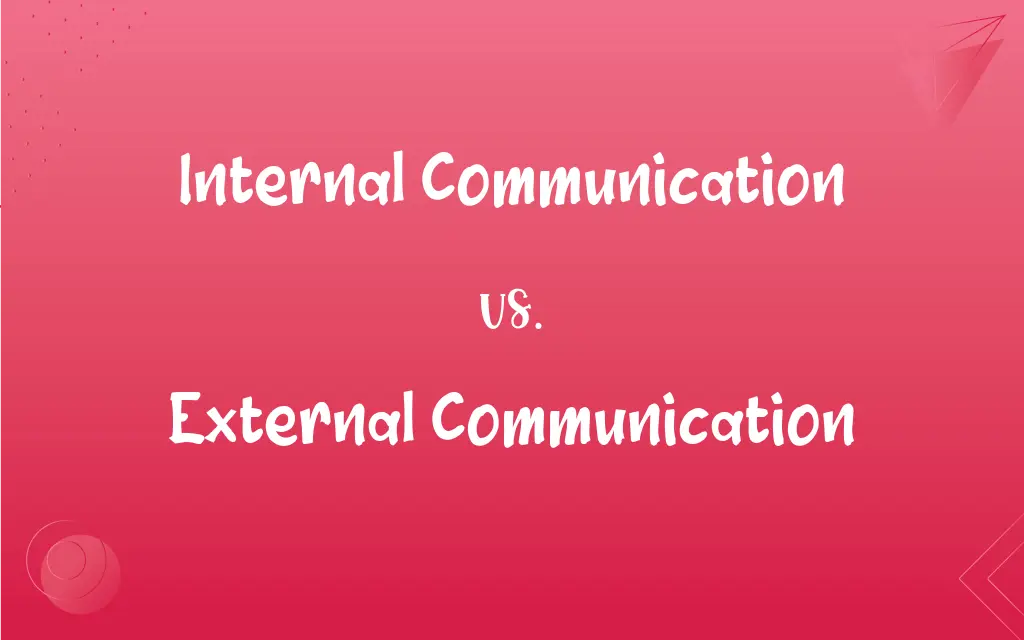Internal Communication vs. External Communication: What's the Difference?
Edited by Aimie Carlson || By Harlon Moss || Updated on October 7, 2023
Internal communication is interaction within an organization, while external communication is interaction between the organization and external entities.

Key Differences
Internal communication revolves around the exchange of information, ideas, or knowledge within an organization. This type of communication is critical for ensuring that all members of an organization are aligned with its objectives and are aware of relevant information. External communication, on the other hand, encompasses all the communication that occurs between an organization and the outside world, such as with customers, suppliers, or other businesses. It plays a vital role in shaping an organization's image and managing its reputation among external stakeholders.
A paramount aspect of internal communication is that it helps in forming a cohesive organizational culture. It encompasses everything from emails and memos to meetings and conferences, all aimed at sharing information and fostering a collaborative environment among the employees. Contrarily, external communication often involves marketing, public relations, customer service interactions, and more, to create a positive perception and establish beneficial relationships with entities outside the organization.
Furthermore, internal communication involves the use of specific channels that are designed to facilitate interaction among members within the organization. It aims at promoting openness, ensuring that everyone is informed, and supporting organizational change. External communication, conversely, utilizes various media and platforms to reach its audience, promoting products, services, or the organization's objectives, and might be directed towards attracting customers, partnering with businesses, or maintaining regulatory relationships.
Effective internal communication can significantly impact employee engagement, satisfaction, and retention by making employees feel valued and informed. In contrast, external communication influences the organization’s standing and relationships in the external environment, affecting its profitability and market position by determining how it is perceived by consumers, competitors, and regulators.
Lastly, while internal communication might be more candid and direct since it is centered on informing and engaging employees, external communication often involves more strategically crafted messages, ensuring they are apt for public consumption and achieve their intended purpose, be it sales, brand positioning, or customer engagement.
ADVERTISEMENT
Comparison Chart
Purpose
Facilitates information sharing within the organization.
Aims to build the organization's image and relationships externally.
Audience
Targets employees and stakeholders within the organization.
Directed towards external entities like customers, partners, and public.
Tone and Language
Often informal, direct, and may utilize internal jargon.
Usually formal, polished, and free from organizational jargon.
Confidentiality
May involve confidential or internal-use-only information.
Typically consists of information intended for public view.
Objective
Aims to align internal teams, manage change, and boost morale.
Seeks to enhance public perception, build brand and form external relationships.
ADVERTISEMENT
Internal Communication and External Communication Definitions
Internal Communication
Internal communication aids in the seamless execution of organizational changes and strategies.
A town hall meeting, a form of internal communication, was held to discuss the new strategic plan.
External Communication
It is a means to build relationships with external entities like customers, partners, and investors.
Attending trade fairs, a form of external communication, allowed the company to engage with potential clients.
Internal Communication
It acts as a medium to share feedback and foster a two-way communication channel within an organization.
Employees were encouraged to voice their concerns through the internal communication platform.
External Communication
External communication is the transmission of information between the organization and its external stakeholders.
The company utilized external communication by releasing a press statement about its latest product.
Internal Communication
It's a tool for instilling company values and objectives among staff members.
Through internal communication, the team was reminded of the importance of customer satisfaction.
External Communication
External communication employs media releases, newsletters, and digital platforms to communicate with the public.
Monthly newsletters, an external communication method, were sent to subscribers, updating them on company news.
Internal Communication
Internal communication is the exchange of information within an organization.
The CEO sent an email as a part of internal communication to announce the new policy changes.
External Communication
External communication encompasses advertisements, PR, and customer communications to convey the brand message.
The advertisement, a tool of external communication, showcased the company's commitment to sustainability.
Internal Communication
Internal communication encompasses methods like emails, newsletters, and meetings to convey messages within an entity.
The manager used internal communication, via a memo, to update the team about the upcoming audit.
External Communication
It involves using strategies to create a favorable image of the organization in the public eye.
Through social media, a platform for external communication, the company responded to customer queries.
FAQs
How does technology impact internal communication?
Technology facilitates efficient internal communication through platforms like intranets, emails, and collaboration tools, ensuring timely and interactive information exchange.
What is the primary purpose of internal communication?
Internal communication aims to disseminate information, foster unity, and enhance collaboration within an organization.
Can external communication affect a company's reputation?
Yes, external communication, if managed well, can enhance or, if mishandled, potentially damage a company’s reputation among its external stakeholders.
Can internal communication impact employee morale?
Yes, effective internal communication can significantly influence employee morale by making them feel valued, informed, and engaged.
How is feedback collected in internal communication?
Feedback in internal communication can be collected via surveys, meetings, suggestion boxes, or digital platforms that allow for employee input.
Is internal communication confidential?
Typically, internal communication can contain confidential information meant solely for employees and internal stakeholders.
What channels are commonly used for internal communication?
Common channels include emails, intranets, newsletters, and face-to-face meetings for internal communication.
How is external communication aligned with a company’s branding?
External communication delivers consistent messages, visuals, and interactions that uphold and reflect the company’s brand identity and values.
Who are the target audiences for external communication?
Target audiences for external communication include customers, investors, media, regulators, and the general public.
How does external communication contribute to marketing?
External communication employs various strategies and platforms to promote products/services, attract customers, and position the brand in the market.
How can internal communication enhance productivity?
By keeping employees informed, engaged, and aligned with organizational goals, internal communication can boost morale and enhance productivity.
Which tools are essential for effective external communication?
Tools like social media platforms, press releases, advertisements, and public relations campaigns are essential for external communication.
How can internal communication support change management?
Internal communication helps in articulating the need for change, explaining new policies, and mitigating resistance among employees during change management.
How do organizations manage negative publicity through external communication?
Organizations manage negative publicity by formulating strategic responses, being transparent, and using external communication to convey their side of the story.
How is technology reshaping external communication?
Technology enables organizations to leverage digital platforms for wider reach, personalized messaging, and interactive external communication.
Who is responsible for internal communication within an organization?
While it can vary, typically HR, corporate communication teams, or leadership manage internal communication.
Why is external communication crucial for an organization?
External communication is vital for creating a positive public image and building relationships with customers, suppliers, and other stakeholders.
What role does external communication play in crisis management?
External communication is crucial in crisis management to control narratives, maintain public trust, and manage stakeholders’ perceptions and responses.
How can external communication be measured effectively?
External communication can be measured using metrics like audience reach, engagement, lead generation, and conversion rates.
What challenges are often encountered in internal communication?
Challenges may include information overload, ensuring message clarity, maintaining engagement, and ensuring two-way communication.
About Author
Written by
Harlon MossHarlon is a seasoned quality moderator and accomplished content writer for Difference Wiki. An alumnus of the prestigious University of California, he earned his degree in Computer Science. Leveraging his academic background, Harlon brings a meticulous and informed perspective to his work, ensuring content accuracy and excellence.
Edited by
Aimie CarlsonAimie Carlson, holding a master's degree in English literature, is a fervent English language enthusiast. She lends her writing talents to Difference Wiki, a prominent website that specializes in comparisons, offering readers insightful analyses that both captivate and inform.































































